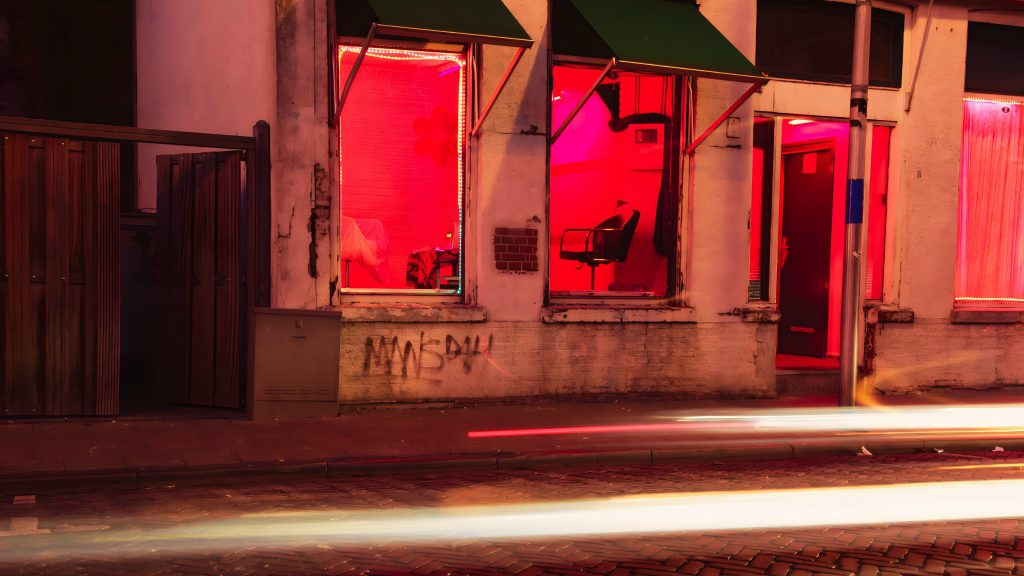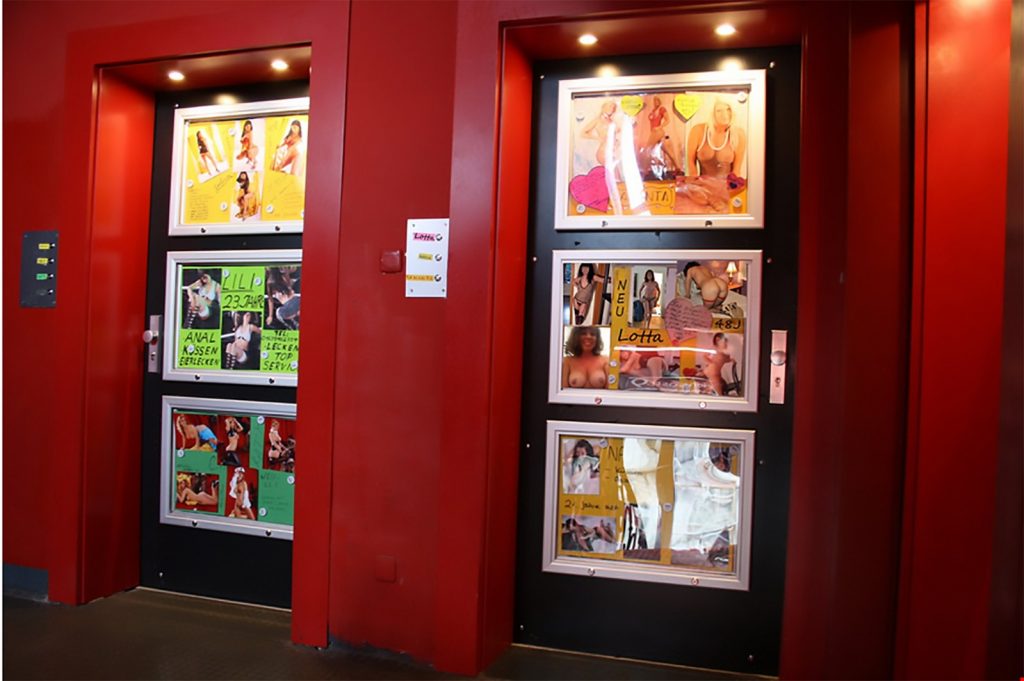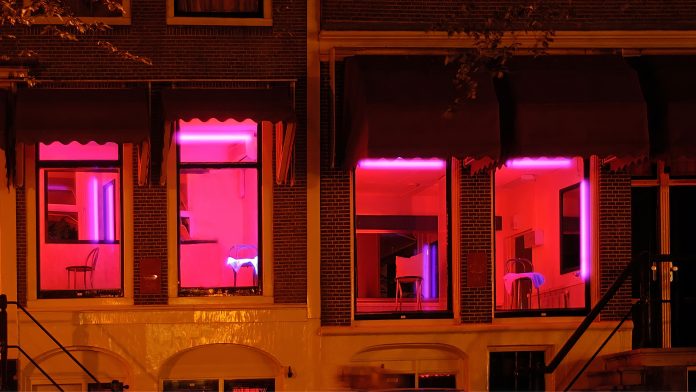The infamous red-backlit windows may soon disappear from Amsterdam as the Dutch capital attempts a new strategy to deal with the on-going criminal activity plaguing its legal red-light districts.
Though Amsterdam has become synonymous with normalized, legal prostitution in pop culture, the city has been struggling to combat the unsavory side-effects of having a sexual free-for-all — grappling with everything from littering, drunk rioting, public masturbation, rape, and trafficking in what was once touted as a model approach to prostitution.
The city’s response? Construct a giant, multi-story “erotic center” with 100 rentable rooms. Investors are being courted by the city and asked to propose a plan which includes security, social services, health care, hospitality, a strip club, entertainment, sex education, and Pride events for the public – in the hopes that the sex trade in Amsterdam will finally become “clean” and “safe.”
In other words… a mega-brothel.

This is not a novel idea.
In Germany, these sex industry citadels have been around for decades. For example, look at Pascha in Cologne, which is a 12-story, 126-room high-rise built in the early 1970s for the specific purpose of removing prostitution from the inner city. The project had the blessing of the local government, and the building features a self-contained internal economy including a restaurant, pizzeria, several bistros and bars, a beauty salon, clothing boutique, tanning studio, and gym. The brothel even has its own newspaper.
The ground floor is largely taken up by a strip club which is rented out for cultural events including concerts. In 2013, there were 150 women renting rooms and 90 supplementary staffers working in the bar, cleaning, cooking, providing security, and doing administrative tasks.
During a TV interview, owner Hermann Müller boasted how every woman was paying her taxes, securely insured, and well-cared for.

Despite all these supposedly wonderful measures to “protect” the prostituted women, a 28-year-old Thai woman was robbed and stabbed to death by a sex-buyer inside her room at Pascha in 2003. The next year, two 15-year-old girls were found to have been working in the brothel after a police raid. The year after that, authorities uncovered weaponry and cocaine in the building, and arrested 23 individuals who had fake documentation. Amongst them were young African women whose ages could not be verified.
Various aid organizations can attest to other trafficking cases involving Pascha or its affiliated brothels over the years, including at least one 17-year-old girl who had not been allowed out of her room for 9 months. In 2006, another young woman was nearly fatally wounded by a sex-buyer using a knife. In 2015, a man strangled a woman after renting her, with the victim just barely making it to her panic button to call for help. Among the most disturbing incidents I can recall was how in 2007, an 18-year-old woman inside a Pascha chain brothel in Salzburg, Austria, gave birth. In a fit of complete shock and post-natal psychosis, she threw the infant out of the window.
And these are just some of the incidents that made it into the press, and not remotely exhaustive.
Legal brothels will often point to retained security services as evidence they care about the well-being of the women in the facility, but those familiar with the industry know the “protection” comes with a dark trade off.

As many prostitution survivors can attest, the men who work brothel security are often dangerous individuals and not necessarily “allies” to the women. Security firms are notorious for being run by gang-members and ex-cons – with Pascha being an excellent illustration of this fact.
In 2010, five brothel bouncers were charged with aggravated assault for beating a man likely to have been a member of a rival gang within an inch of his life. A witness described them as having been wearing gloves with sand inserts and shoes with steel caps. This force is perceived as being able to easily intimidate or beat women into silence.
This is exactly what happened at the Paradise mega-brothel in Stuttgart, Germany. The self-described “wellness center” was funded to the tune of €6,000,000 (approx.$6.5 million USD) in 2008. Operators boasted about having two administrators for women’s complaints, an in-house gynecologist and a round-table with municipal regulators, tax officers and police. Other supposed displays of benevolence included educational events for the women regarding retirement funds and healthy eating.
Every prostituted woman at Paradise had to fill out a form with the precise sexual practices she offered, agree to have her coming and goings tracked, and allow her documentation to be openly shared with authorities.
And yet, despite all of these measures, it only took one year for the first trafficking victim to be uncovered — an 18-year-old who was being exploited by a personal friend of the brothel’s operators.
Paradise was raided in 2014 by police, and its owners were charged with sex trafficking, physical assault, and the forced “branding” of women as though they were human cattle.
Just two years later, a married father-of-four stabbed a 25-year-old Romanian prostituted woman to death, and soon after Paradise’s public relations manager was sentenced for bodily assault – his tenth time being charged by a German court.
Paradise operators were finally held to account in 2019 after admitting to utilizing gangs to keep the brothel “supplied with women.” The victims were often raped by up to 10 men per day. And all of it was happening in a legal, “clean,” well-staffed brothel.

But Pascha and Paradise are not outliers.
The Leierkasten – Bavaria’s biggest brothel – was operated for years by a man implicated in contract killing.
The Artemis in Berlin, a mega-brothel famous for having hosted socialist, pro-“sex work” streamer Hasan Piker, was known to have been a site of sex trafficking involving the Turkish Hells Angels.
The Pussy Club chain – an “all-you-can-fuck” brothel – was discovered to have been involved in the trafficking of very young Romanian women who were raped by up to 60 men per day, some to the point of collapse.
The Eros Center brothel chain has been the site of several rapes, kidnappings, trafficking of adults and minors as well as murders.
Many more mega-brothels have been exposed as sites of criminal activity – the list is endless.
There is overwhelming evidence that, despite the claims of liberal activists, mega-brothels, like other manifestations of the “legal” sex trade, only benefit pimps and johns. But beyond that, they exist as a kind of distinct marker in a city’s landscape that makes clear its position on women’s place as commodities.
Such institutions give a veneer of lawfulness and safety while delivering neither. Its tight-knit internal economies are a gift to sex traffickers who can let their victims eat pizza, get their hair done, and get STI screening without ever leaving the premises. Women’s coming and goings are tightly controlled by bouncers, themselves a highly shady group of men.
As though it were not already obvious that such institutions were premised on shrouding their activities in darkness, most mega-brothels also bar entry to non-prostituted women, lest they be sexually harassed or disturb the “man-cave” atmosphere by witnessing what really happens inside those walls.
But what is inside often spills out, with drunk brothel customers sometimes being spotted surrounding neighborhoods. Such concerns have already lead the Amsterdam mega-brothel to consider relocating. One Dutch mother recently spoke to her local press and expressed her concerns that one of the proposed locations would be too close to her daughter’s primary school.
The reality is that these “mega-brothels” do nothing to improve the safety or dignity of the prostituted women inside, and will be dubiously successful at best in its attempt to contain the filth the sex trade brings to its surroundings outside. If anything, Amsterdam’s latest venture should be seen as an admission that its legal sex trade project has been a failure. Now, rather than walking that failure back, it’s simply trying to control its profoundly damaging impact.
The city will get its tax money but, if history is any indication, the women inside the “mega-brothel” won’t leave with much, if they leave at all.
Reduxx is your source of pro-woman, pro-child safeguarding news and commentary. We’re 100% independent! Support our mission by joining our Patreon, or consider making a one-time donation.
